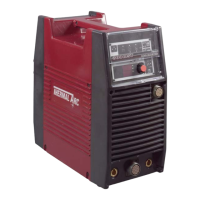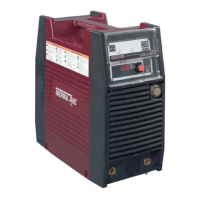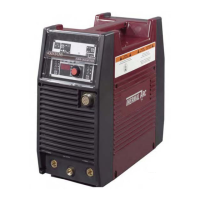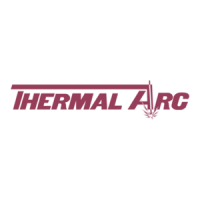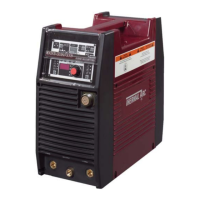Do you have a question about the Thermal Arc Arcmaster 400 MST and is the answer not in the manual?
Details potential dangers associated with arc welding, including electric shock and fumes.
Lists key safety standards and regulations relevant to welding operations.
Details compliance with relevant European Directives and national legislation.
Explains how to navigate and interpret the manual's structure and warnings.
Details how to locate and record the unit's identification number (model, serial).
Instructions for checking equipment upon delivery for completeness and damage.
Describes the ARC MASTER 400 MST as a DC arc welding power source.
Illustrates the internal functional block diagram of the 400 MST power supply.
Provides guidelines and warnings for safely lifting and transporting the welding unit.
Details the recommended environmental conditions for operating the welding equipment.
Provides guidelines for selecting a suitable location for the welder, considering ventilation.
Explains how to safely connect the welding power source to the electrical input supply.
Specifies AC power supply requirements, voltage matching, and fuse selection.
Describes the unit's inrush circuit, voltage sensing, and primary current recommendations.
Emphasizes correct installation of HF equipment and potential interference issues.
Explains how high frequency energy can be transmitted and cause interference.
Defines duty cycle and warns about exceeding ratings, which can cause shutdown.
Lists detailed technical specifications of the ARC MASTER 400 MST welding equipment.
Identifies and describes the main controls on the front panel of the power source.
Explains the function of each weld parameter and its effect on welding performance.
Details how to select different weld modes (STICK, MIG, LIFT TIG) and their parameters.
Provides detailed descriptions of specific weld parameters like WELD(V), INDUCTANCE, HOT START.
Presents a table summarizing weld parameters and their ranges for different welding modes.
Highlights key features of the power source, including digital controls and cooling.
Step-by-step guide on connecting and setting up for Stick welding operation.
Instructions for connecting and setting up the machine for LIFT TIG welding.
Procedure for connecting and setting up the machine for MIG welding operations.
Explains how to save and retrieve welding parameter programs using Save/Load buttons.
Explains how to connect TIG torch and work lead for direct current straight polarity.
Provides a table of current ranges for various tungsten electrode sizes.
Details electrode types, their applications, features, and color codes.
Offers guidance on selecting filler wire diameter based on AC/DC current ranges.
Lists recommended shielding gases for different metal alloys used in welding.
Provides TIG welding parameters for steel pipe, including electrode type and filler rod.
Presents DC TIG welding parameters for steel based on thickness and joint type.
Explains the correct electrode polarity connection for stick electrodes.
Discusses the effects of stick welding on different metal types and material properties.
Guides on setting Wirespeed and Voltage controls for optimal MIG welding.
Explains how MIG torch angle affects the weld run width.
Specifies the recommended electrode stick-out distance from the MIG torch nozzle.
Discusses how travel speed influences weld width and penetration.
Details factors influencing electrode wire size selection for MIG welding.
Compares deposition rates and productivity when using different electrode wire sizes.
Outlines the cleaning and inspection procedures for the power supply unit.
Addresses common MIG welding issues like porosity and inconsistent wire feed.
Troubleshooting guide for common MIG welding defects and their causes/remedies.
Troubleshooting guide for common TIG welding issues affecting weld quality.
Identifies common problems in Stick welding and provides solutions.
Troubleshooting guide for issues related to the welding power source itself.
Provides technical specifications for the Voltage Reduction Device (VRD).
Outlines routine inspection and testing procedures for the VRD.
Step-by-step instructions on how to enable or disable the VRD function.
Details common error codes displayed by the power source and their troubleshooting.
Lists part numbers and descriptions for available accessories for the welder.
Details the warranty periods for welding equipment, cutting equipment, and accessories.
Provides contact details for Thermal Arc customer service worldwide.
| Brand | Thermal Arc |
|---|---|
| Model | Arcmaster 400 MST |
| Category | Welding System |
| Language | English |
